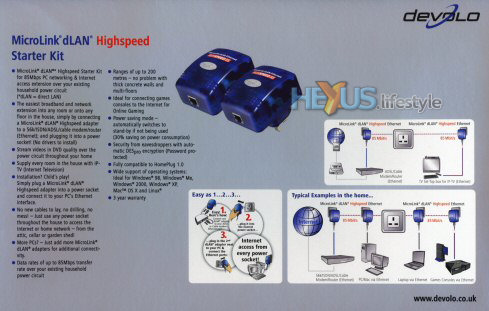Elegant and easy - on all OSs
If you check out the buying links on devolo.uk's site, you'll see that the kit is available on the net at a range of prices, starting from about £117, including VAT and delivery. That's not cheap for a kit that - without using a network switch - connects only one device to a network but there are significant compensations.It's no exaggeration to say that, in use, devolo's MicroLink dLAN Highspeed Starter Kit is one of the most elegant pieces of hardware we've tried in all the many years we've been going hands-on with computers - stretching back to the days of CP/M. It's probably one of the easiest to get running, too.
No drivers have to be installed and there's no absolute need even to install the supplied software - whether running Windows, Linux or Mac OS - though, as we'll explain, that very slight effort is worth making.
There are two adaptors in each devolo starter kit and extras can be bought singly if you need an odd number - though it's cheaper to buy pairs in a kit. For our initial round of tests, we used the two Ethernet cables that devolo supplies in-pack, connecting one adaptor to an ADSL router and the other directly to the Ethernet port of a PC or network media player.
We think that many potential buyers will be doing things in a similar way given that they'll likely be broadband subscribers who want to share their internet connections with other PCs around the house and also may wish to view and listen to - away from their desks - the digital media that is on their PCs.
For us, the devolo products worked out of the box - with no fuss and no bother. We successfully tried four different PCs and multiple operating systems - going onto the net using Windows XP (Home and Pro), Windows 98SE and V5 of the Linspire Linux OS. File transfers over the mains also went without a hitch on these OSs.
We didn't have a Mac available but have little doubt that things would have worked equally well under Mac OS X. We carried out a variety of test for network speed and usability in various rooms using a number of PCs - but used only Windows XP Pro or Home for these tests.
A Pinnacle ShowCenter 200 network media player worked sweetly, too. We were able to watch on TV - on the first floor of our east London offices - a wide range of video files, including 1080i Windows Media HD AVIs and non-copy-protected DVD VOBs. These were were streaming smoothly across the mains from an old Celeron 1.4GHz WinXP Pro PC located downstairs.
Not surprisingly, we also had no problems viewing still images or listening to MP3 music files over the mains via the ShowCenter. Watch out for a forthcoming review of Pinnacle's compact network media player but, in the interim, you can check out the product's home page.
If you have PCs and network media players with Ethernet ports that are set up to automatically obtain network addresses (IP addresses, that is), then we'd be pretty confident that the devolo kit will work out of the box for you, too. In case your PC's not set up this way, we're also providing, on page eight and nine, a simple (but far-from-comprehensive) guide that explains how to set up a Windows XP so that it does obtain an IP address automatically.
From the many tests were carried out, we can see that it's not hard to contrive a situation where performance can be disappointing. In most cases, though, a little bit of trivial experimenting can bring the speed right back up to where it ought to be.
So, let's now take a closer look at the devolo adaptors and what comes in the starter kit.



